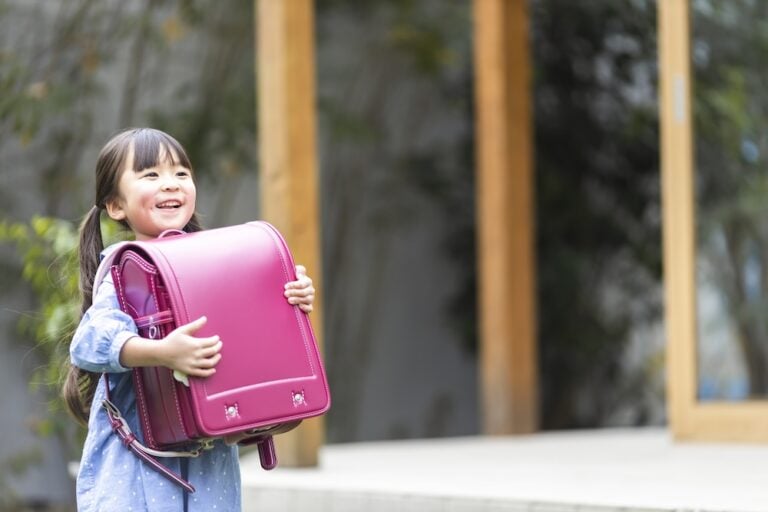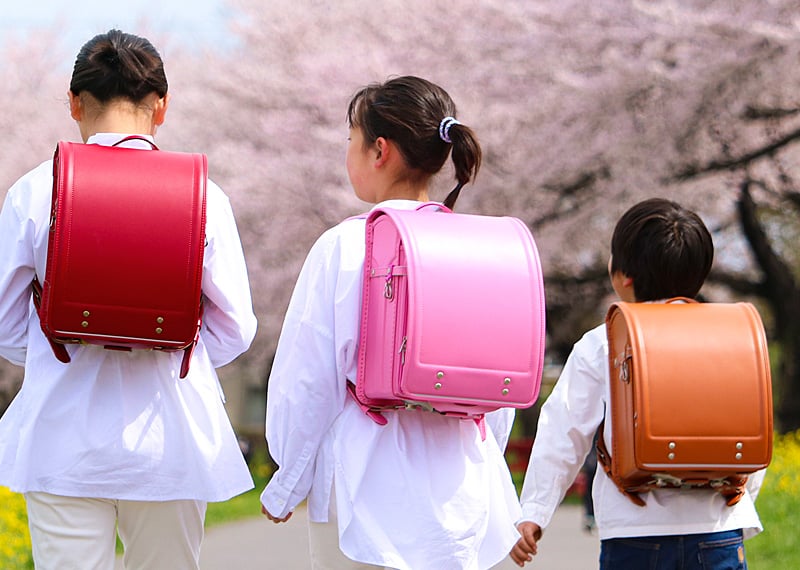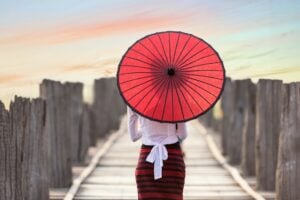
Growing up as a public school kid in the United States, the new school year brought with it nerves, but also excitement. One of my favorite memories is choosing a backpack to carry books, stationary, and my lunch box to and from school. I still remember my kindergarten bag – a shiny pink number with the PowerPuff Girls emblazoned on the front. It was a statement piece for sure, and probably one of the more fashion-forward moments in my life.
6-year-olds in Japan have this same opportunity, and it is undoubtedly equally exciting for them. The bags themselves, however, are nothing like what I or any of my peers used. That’s because in Japan, the most popular (and in many cases only) school bag is the randoseru (ランドセル).
No PowerPuff Girls in sight here.
Randoseru’s history
Unlike many loanwords in Japanese, the name randoseru is derived from the Dutch word for backpack: ‘ransel’. Sure enough, if you look at depictions of Dutch infantry backpacks when the word was introduced to Japan in the late 1800s, there are some clear similarities in design.
More specifically, randoseru were first used in 1885 by an educational institute in Tokyo called 学校法人学習院. As the institute was famously attended by much of the Japanese royal family, many aspects of the school – including fashion choices – received a lot of attention from the public. In 1887, an iteration of the randoseru that closely resembles the modern version was gifted to the young crown prince of Japan. This is largely seen as the point which transformed the Japanese ‘ransel’ from a single school’s designated pack to a nationally recognized school bag.
The original bag used by the Tokyo educational institution was made using canvas, but eventually became leather. This was the last major change to the randoseru, and today’s design is largely the same, although synthetic leather randoseru have become increasingly popular over time.

Characteristics
Randoseru are hard to miss, as they have a unique shape (and usually an elementary school student attached to it). A standard bag is constructed of hard-backed leather in a box shape, and measures 30x23x18cm. While bulky in appearance, the style makes packing books and papers easy for little hands that still lack coordination. The design does mean, however, that the packs are heavier than your average school bag in many other countries. A genuine leather randoseru weighs approximately 1.5 kilograms. And that’s without any books inside! In an attempt to make these bags lighter, recent production of randoseru has begun to include synthetic leather, which brings the weight down to about 1-1.2 kg.
Another reason for the material change was to help bring down the cost of randoseru. Your average leather pack can easily sell for over ¥50,000 (~330 USD), although depending on the company it can run even higher than that.
While the original randoseru were only available in red or black, you can now find them in over 50 different colors. From bright pink to mint green, there’s a shade for every elementary school student-to-be. Brands such as Nike and even Diesel have even been known to create their own takes on these Japanese backpacks. That being said, 6-year-olds aren’t exactly known for their timeless taste, so it’s often the case that they’ll go with the hot pink bag. Since the same randoseru is to be used throughout a student’s elementary school career, I’ve taught many a sixth grader that has resented his or her choice from six years prior.
But why randoseru?
One of the biggest questions (and in some cases assumptions) about these backpacks is whether or not they are required. They must be, seeing as every child seems to use one. But, would it not also be ridiculous and even classist to mandate the use of such expensive bags? Many would probably say yes! However, randoseru are not, in fact, officially required for elementary school children. The government has no mandate about their use, yet they are still the overwhelming majority in both public and private schools.
The ubiquitous desire for randoseru among school children and parents in Japan comes from a blend of practicality, tradition, nostalgia, and, consequently, a desire to fit in with classmates. On the practical side, these bags are designed to place minimal strain on a child’s back even with 12 pounds (5.4 kg) of books packed. The material also makes them water resistant.
As for tradition, randoseru have been widely used since the 1950s when they became the mainstream grade school backpack. At this point, there are multiple generations that have grown up using their own randoseru and eventually seeing their own children being gifted one as well. There’s even a word in Japanese for the process of searching for, finding, and buying these bags: rankatsu (ラン活). In this way, the practice of choosing and purchasing (usually by the student’s grandparents) a bag has, over time, become something of an institution. Randoseru have thus come to symbolize one’s transition from young child to grade school student. It’s a sort of ‘leaving the nest’. The desire to use a randoseru is strong enough that, after working in public Japanese elementary schools for three years, I have yet to see anyone without one – even foreign students!
Alternatives to purchasing new
As you can imagine, these backpacks are quite the financial burden, and although it’s traditionally the grandparents that pay for it, the costs can still be difficult to shoulder. Luckily, there are a few ways to get secondhand randoseru for a lower price. Jmty is an online secondhand platform that allows users to buy and sell items, often even cheaper than secondhand stores like Hard Off or Second Street. I’ve also been told by a Japanese acquaintance of local government-run programs that provide donated packs for free, although I’ve never confirmed this. Whatever method is used to purchase one, it’s best to inspect both new and used randoseru in person to ensure it has enough life in it to last all six years of elementary school.
The randoseru backpack stands as a cultural emblem deeply ingrained in the fabric of Japanese society. Its journey from a utilitarian Dutch-inspired design to a symbol of childhood and academic progression reflects not just practicality but also tradition, nostalgia, and a desire for social integration. The enduring popularity of randoseru in Japan transcends mere functionality, as it also represents a profound connection to one’s parents and schoolmates, as well as the passage of time. As generations continue to embrace the randoseru tradition, it remains a testament to the values of resilience, continuity, and collective identity in Japanese culture.













